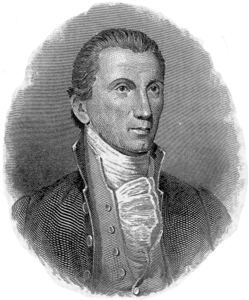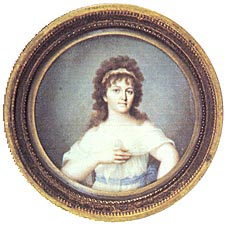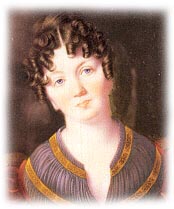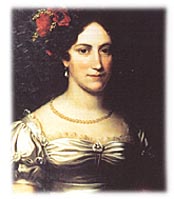“From the commencement of our Revolution to the present day almost  forty years have elapsed, and from the establishment of this Constitution, twenty-eight. Through this whole term the Government has been what may emphatically be called self-government. And what has been the effect? To whatever object we turn our attention, whether it relates to our foreign or domestic concerns, we find abundant cause to felicitate ourselves in the excellence of our institutions. During a period fraught with difficulties and marked by very extraordinary events the United States have flourished beyond example. Their citizens individually have been happy and the nation prosperous.” – James Monroe, First Inaugural Address, Tuesday, March 4, 1817
forty years have elapsed, and from the establishment of this Constitution, twenty-eight. Through this whole term the Government has been what may emphatically be called self-government. And what has been the effect? To whatever object we turn our attention, whether it relates to our foreign or domestic concerns, we find abundant cause to felicitate ourselves in the excellence of our institutions. During a period fraught with difficulties and marked by very extraordinary events the United States have flourished beyond example. Their citizens individually have been happy and the nation prosperous.” – James Monroe, First Inaugural Address, Tuesday, March 4, 1817


5th President of the United States
(March 4, 1817 to March 3, 1825)
He was neither an intellectual, great orator, or talented writer. He was a slow thinker. He liked to review all the perspectives, facts, and facets before he made a conclusion, and he was revered for his sound judgment as a result.
Unlike his longtime friend Thomas Jefferson, and his political peer James Madison, his talent was in the practical implementation of ideals and policies. Both his influence and prestige were due to integrity, honesty, and personal charm. He was a warm and thoughtful man, and was markedly free of any exercise in vindictiveness. His gift was the ability to work with all participants, regardless of their abilities or character. He held on to old school values of the 18th Century, was tall, rather raw in frame, and wore breeches and buckles on his shoes while sporting a tricorne hat (three corners), which was an outdated mode of dress by the time of his presidency. It earned him the nickname of ‘The last cocked hat’.
He was born on April 28, 1758, in Westmoreland County, Virginia, the second of five children born to Spence and Elizabeth Jones Monroe, and Episcopalian in faith. They were not considered the elite in the farming community, having what was by the standard of the time a small 600-acre plantation principally for tobacco.
Monroe’s early education was at Parson Campbell's school in Westmoreland. He entered William and Mary College at the age of sixteen, in Williamsburg, Virginia, studied law, graduated in 1776, and immediately enlisted in the Third Virginia Regiment. He was not a delegate to the Constitutional Convention, and in his own state of Virginia, he supported Patrick Henry’s opposition to the Constitution, as it seemed to young Monroe that this approach would create a centralized government encroaching on states rights. Soon enough though, the thoughts of the Constitution were far from the thoughts of Monroe, as he joined a frontline team that scouted ahead of General Washington’s Army. He crossed the Delaware ahead of the Washington troops, and was wounded in the Battle of Trenton. His recovery was spent at Valley Forge, during a winter that saw the Continental Army reduced to a frail and starving lot. The winter there nearly disbanded the troops from despair and weariness. The lack of food and clothing, arms, shelter, supplies, and the near unbearable cold weighed heavy on Washington’s troops.
Monroe healed to fight again, and advanced in the service to the rank of Lieutenant Colonel by the age of twenty-two. In 1780, he found that a frontline position was not to be made available to him, and he retired from the military to return home to Virginia. Upon his arrival, he began practicing law in Fredricksberg, and was soon introduced to the Governor of the State, Thomas Jefferson. Jefferson and Monroe became quick and sure friends, with the older statesman taking the young, promising lawyer under his wing. Monroe continued to study law under the guidance of Jefferson, and was soon elected to the Virginia legislature in 1782, immediately followed by election to the Continental Congress to serve from 1783 through 1786, under the Article of Confederation. Monroe had demonstrated strong abilities in and total dedication to public service which won him great favor to be elected in 1783 to the Confederation Congress, where he served until 1786. While in the Congress, he organized the opposition of those against the Jay-Gardoqui proposals, which was designed to set the United States to yield to Spain its claim to the free navigation of the Mississippi River.


Eliza, the eldest daughter was born in 1786, followed by the birth of a son, James Spence Monroe, born May 1799 and whom died in infancy in September 1800, and Maria Hester, the youngest of his children, who was born 
While helping to lay the groundwork for territorial government embodied in the Northwest Ordinance of 1787, he joined those who advocated a stronger government, which was a continuation of the work of his friend, James Madison. During that same time, he aligned with Patrick Henry and George Mason against the ratification of the U.S. Constitution, believing that it granted excessive powers to the Senate and was flawed in authorizing direct taxes.
The Ordinance and the Constitution held one facet that was common. Fugitive slave laws provided for the return of runaway slaves who escaped to another state. A portion of the Northwest Ordinance of 1787 provided for the return of slaves who had escaped to the free Northwest Territory. The Constitution of the United States went into effect in 1788, and also provided for the return of fugitive slaves.
Monroe was a US Senator from 1790 through 1794. He was a great lieutenant of Jefferson’s perspective, and a dedicated opponent of George Washington, Alexander Hamilton, and the Federalists. Monroe joined with James Madison, who was a Congressman, to combat the domestic measures proposed and advocated by Alexander Hamilton. The Anti-Federalists vigorously opposed these measures which emphasized centralization of powers in the federal government. Monroe also opposed President Washington’s pro-British foreign policy. Monroe, Jefferson and Madison began organizing the Republican Party. Monroe was assigned in this effort to contribute his talents in the realm of political strategy, and he was the central figure in coordinating liaison with anti-Hamilton forces in other states. He was an energetic supporter of Madison in defending the Republican position in the press.
Again, in 1793, the U.S. Congress addressed the slavery issue and passed a fugitive slave law allowing owners to recover slaves merely by presenting proof of ownership before a magistrate. Upon proof, the magistrate would issue an order for the arrest and return of the escaped slaves, who were forbidden a jury trial and the right to present evidence to defend themselves. It was a law that was often bent or broken for other purposes as free blacks in the North were sometimes kidnapped and taken to the South as slaves. Many from the Northern states recognized the abuse of the law and some issued orders not to help recover fugitive slaves.
The turmoil in the United States over slavery was an issue that was often fueled in the interest of politics. The balance of power was often treacherously perched on the ratification of states and what was perceived to be equality of representation. Instead of a focus on the law or the established, many tallied the pro and con of what was a racial issue but was viewed as a property issue. Slaves were chattel in the process, whether freed or held, and the position of the states became central in the division of political power. It would be a divide that would come into the path of America in many ways, a nation that has yet to fully heal from the wounds of the early entrenched ideals.
Monroe was appointed by Washington as Minister to France in 1794. Washington the hoped that the Monroe sympathy for France would clam the tense relations between the two nations, but Monroe did nothing to lessen French resentment over Jay’s Treaty. Monroe was more of a Republican spokesman than an envoy for the President, and subsequently was recalled in 1796. The recall was the handy work of Secretary of State Timothy Pickering, and Monroe defended himself by publishing a harsh attack on Washington's foreign policy.
In 1799, Monroe was elected Governor of Virginia and served until 1802. He demonstrated great administrative ability and won tremendous praise for his decisive action that suppressed a slave uprising known as Gabriel's Insurrection in 1800. He purchased the plantation known as Ashlawn-Highland next to Monticello in 1799, and he and his family called this home for 24 years. Two of his children were born there. From there, he was an avid supporter of Thomas Jefferson for President, who was sworn into office on March 4, 1801.
Jefferson had seen and knew first hand the abilities of Monroe. He had tutored him well and the two had formed an impenetrable friendship and trust relationship. His value in 1802, as Jefferson envisioned, was his relationship with the French. Jefferson sent Monroe to France as his special envoy, and later, to assist Robert R. Livingston with negotiations regarding the Louisiana Purchase in 1803. Then in Spain, he was to aid Charles Pinckney in negotiations with the Spanish government, but they were unsuccessful in their efforts. In 1803, Monroe was Minister to France and England, and was to negotiate a commercial treaty with the British, but he and William Pinkney, there to assist, could not secure concessions from the British. Jefferson was disappointed in the draft of the proposal submitted by Monroe and Pinkney submitted in 1806, declining to submit it to the Senate.
He returned to the US in 1807, and began a bid for the presidency in 1808. The move alienated Madison for a time, but the estrangement did not last. Monroe was again, elected Governor of Virginia, and in 1811, Madison appointed him to the prestigious post of Secretary of State in his administration, a position that Monroe held throughout the presidency of Madison, until 1817. Monroe was admired by many, including the younger Congressman, and he proved to be very instrumental in securing the cooperation of the War Hawks, and advancing administration policies and agendas for Jefferson.
When the War of 1812 was declared, Monroe was hungry for a field assignment. Having advanced to the position of Lt. Colonel before his retirement from the Continental Army, he felt he would be an asset to the war effort. However, Secretary of War, John Armstrong, the brother-in-law of Robert R. Livingston, denied Monroe’s request for assignment. It was long held that Armstrong resented Monroe and felt that he had deprived Livingston of his claim as the negotiator of the Louisiana Purchase.
The tables were turned by President Madison when the Capital was invaded by the British due to the failure of Armstrong to organize a proper defense, and Madison replaced the disgraced Secretary of War with Monroe.
Monroe’s service and political history made him the obvious choice for the presidential elections to succeed Madison. The Republican Caucus nominated Monroe as their candidate over William H. Crawford, in a nation that had grown to nine million in population. He was the first President to have been a US Senator. Crawford soon succeeded Monroe as Secretary of War. Monroe handily defeated the Federalist candidate, Senator Rufus King of New York, in an Electoral College vote of 183 to 34. The Federalist Party had been crushed due to its opposition to the War of 1812, which they dubbed “Madison’s War.
The inauguration of President Monroe was the first to be held out of doors, and the first to include the Marine Band. Soon after the festivities and assuming office, Monroe adopted a conciliatory policy toward the Federalist critics of the war. He immediately began a tour of the New England states, where talk of secession had been prevalent. The Federalist sympathizers rallied to welcome the President and demonstrate loyalty to him. A Boston newspaper coined the times by calling it the ‘Era of Good Feelings’. Monroe’s goal was to end party rivalry and place free government on a solid foundation of support, but the times were to change in his second term of office, with deep divisions and party rivalries emerging to restore the two-party system.
In foreign affairs a number of settlements were reached. The Rush-Bagot agreement with Great Britain (1817) provided for mutual limitation of armaments on the Great Lakes, and the U.S.-Canadian boundary question was also settled. Congress fixed the number of stripes on the U.S. flag at 13 to honor the original colonies, April 4, 1818. The Anglo-American Convention set the 49th parallel as the border with Canada.
In 1818, the Territory of Missouri, which was part of the Louisiana Purchase, applied for admission to the Union. Slavery was legal in the Territory of Missouri, with approximately 10,000 slaves living there. The people expected Missouri to become a slave state. At the time the bill to admit Missouri was introduced, there were an equal number of free and slave states. Six of the original 13 states and five new states permitted slavery, while seven of the original states and four new states did not. Each, free or slave state, had 22 senators in the United States Senate. The possibility of admitting Missouri threatened to destroy this balance.
It was an age-old challenge. The questions of free and slave boundaries had been easily defined by the Mason Dixon Line and the Ohio River, but there was no such boundary west of the Mississippi River. Missouri was in a quandary with the old boundaries, as part was north and part south of the Ohio. It was a feverish debate that evoked when Representative James Tallmadge of New York introduced the amendment to the bill enabling Missouri to become a state. The proposed amendment would prohibit bringing any more slaves into Missouri, and would grant freedom to the children of slaves born in Missouri after its admission. Southerners were disturbed that this would put an end to the cotton growing, as they had found slave labor increasingly profitable. Free states dominated the House of Representatives, and the slave states felt they must keep the even balance in the Senate.
The Amendment passed the House, but the Senate defeated it. At the next session of Congress, Maine applied for admission to the Union. Missouri was coupled with the Maine application, and the balance was met without upsetting the Senate balance between free and slave states. The Missouri Compromise was then possible. Maine was admitted as a free state and Missouri was authorized to form a state constitution. In addition, the compromise banned slavery from the Louisiana Purchase north of the southern boundary of Missouri, the line of 36 degrees 30 minutes north latitude, except in the state of Missouri.
The people of Missouri wanted the right to decide about slavery in their state. They wrote a constitution that allowed slavery and that restricted free blacks from entering the state.
Florida was ceded by Spain on February 22, 1819, and in exchange, the U.S. cancelled $5 million in Spanish debts. U.S. possession of the Floridas was confirmed by Andrew Jackson’s campaigns and a treaty with Spain.
Monroe's administration was hampered by the economic depression brought on by the Panic of 1819 and by the debates over the Missouri Compromise that same year. In the 1820 election, despite economic depression, Monroe lost only one vote in the electoral college that reelected him. The one New Hampshire delegate that voted against him was said to have done so to maintain that George Washington was the only president elected unanimously. The vote was 231 to 1.
During his second administration, serious differences over the question of slavery in the territories were accommodated by the Missouri Compromise, which Monroe signed despite his sympathy for the South regarding this matter. Before Congress would admit Missouri, a second Missouri Compromise was needed. Henry Clay, the Speaker of the House, helped forge the agreement. It required that the Missouri legislature not deny black citizens their constitutional rights. With this understanding in place, Missouri was admitted to the Union in 1821.
“In a government which is founded by the people, who possess exclusively the sovereignty, it seems proper that the person who may be placed by their suffrages in this high trust should declare on commencing its duties the principles on which he intends to conduct the Administration. If the person thus elected has served the preceding term, an opportunity is afforded him to review its principal occurrences and to give such further explanation respecting them as in his judgment may be useful to his constituents. The events of one year have influence on those of another, and, in like manner, of a preceding on the succeeding Administration. The movements of a great nation are connected in all their parts. If errors have been committed they ought to be corrected; if the policy is sound it ought to be supported. It is by a thorough knowledge of the whole subject that our fellow-citizens are enabled to judge correctly of the past and to give a proper direction to the future.” - President James Monroe, Second Inaugural Speech, Monday, March 5, 1821, given at newly the rebuilt Hall of the House of Representatives.
(** In 1848, Congress passed the Oregon Territory bill, which prohibited slavery in the area. President James K. Polk signed the bill because the Oregon Territory lay north of the Missouri Compromise line. Later proposals tried to extend the line by law across the continent to the Pacific Ocean. These efforts failed. The Missouri Compromise was repealed by the Kansas-Nebraska Act of 1854.)
The Monroe Doctrine was expressed during President Monroe’s seventh annual message to Congress, December 2, 1823. Not only must Latin America be left alone, he warned, but also Russia must not encroach southward on the Pacific coast. ". . . the American continents," he stated, "by the free and independent condition which they have assumed and maintain, are henceforth not to be considered as subjects for future colonization by any European Power." It was not until 20 years after Monroe died in 1831, this became known as the Monroe Doctrine. During this time, the experiment of the American Colonization Society in settling Liberia was undertaken with Monroe’s blessing, and Monrovia was named for him. Monroe himself was torn between his belief in the "evil of slavery" and his fear of the consequences of immediate abolition.
Even in those times, presidents were subject to some unusual press tactics. The woman known as the first American woman journalist, Anne Royall, was a woman known for her eccentric ways. She bought an old printing press and published a newspaper in Washington. She could not get an audience with Monroe, but had heard that he took a dip in he Potomac each morning about dawn. As was rumored, Monroe showed up at the river one morning after Monroe had removed his clothes and was swimming, and sat on his clothes, refusing to leave until he answered her questions.
On New Year's Day, 1825, at the last of his annual White House receptions, President James Monroe made a pleasing impression upon a Virginia lady who shook his hand and later remarked:
"He is tall and well formed. His dress plain and in the old style.... His manner was quiet and dignified. From the frank, honest expression of his eye ... I think he well deserves the encomium passed upon him by the great Jefferson, who said, 'Monroe is so honest that if you turned his soul inside out there would not be a spot on it.' "
Monroe once said: "The truth is that all men having power ought to be mistrusted."
At the end of his term Monroe retired to his estate, Oak Hill, near Leesburg, Va. A little over a year after his return home, Jefferson died at Monticello. In 1829, he presided over the Virginia constitutional convention and supported the conservatives on suffrage and slavery. This was his last public service position.
As was Jefferson, Monroe so deeply in debt by years of public service that it he was in danger of losing all of his property. He had never settled his accounts (some dating from his first mission to France) with the government, and he was seeking reimbursement with accrued interest. Many congressmen considered the claims excessive, and President Andrew Jackson's hostility toward Monroe blocked an immediate settlement. In 1831, Congress granted him $30,000, or half the claim. His last public service was as a presiding officer of the Virginia constitutional convention.
Mrs. Madison died in 1830. Monroe became to infirmed to care for himself and went to stay with his daughter. He died on July 4, 1831, exactly five years after Jefferson and Adams, at the home of his youngest daughter, Maria Hester, in New York City. He was initially interred in New York, but was moved to Richmond in 1858.
|
The men of his Administration - |
Vice President: Daniel D. Tompkins (1817-1825)
Cabinet:
Secretary of State John Quincy Adams (1817-25)
Secretary of the Treasury William H. Crawford (1817-25)
Secretary of War John C. Calhoun (1817-25)
Attorney General Richard Rush (1817)
William Wirt (1817-25)
Secretary of the Navy Benjamin W. Crowninshield (1817-18)
Smith Thompson (1819-23)
Samuel L. Southard (1823-25)
